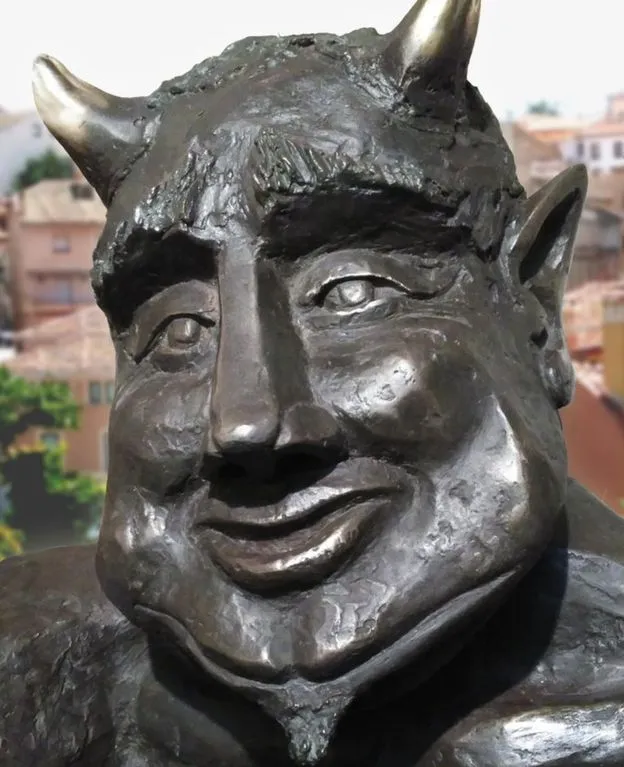Why a Smiling Statue of Satan Is Stirring Up Controversy in Spain
Some Segovian locals say the affable bust is “offensive for Catholics, because it constitutes the glorification of evil”
/https://tf-cmsv2-smithsonianmag-media.s3.amazonaws.com/filer/9f/91/9f91ae92-7532-44ce-a0b6-9bd0a825a0cb/7370.jpg)
According to a local legend, the Spanish city of Segovia can thank the devil for its aqueduct.
As the story goes, a girl tasked with hauling heavy buckets of water across steep streets propositioned the devil to create a means to carry the water for her. If the devil could finish the job by the end of the night, she agreed to pay for the deed with her soul.
The devil toiled away, stacking brick after brick. Meanwhile, the girl, experiencing a sudden change of heart, began fervently praying for her soul’s salvation. It worked. According to legend, the devil was just one stone away from completing the aqueduct when the night ended, releasing the girl from her contract and leaving the town of Segovia with a fancy new aqueduct.
To pay tribute to the aqueduct’s origin story (which has proven quite the tourist draw), the local council commissioned a sculpture of the devil last year. Set to be erected by the ancient Spanish city’s north wall, it depicts the devil smiling for a selfie, a nod to Segovia’s history and the tourists the devil has “lured” there.
But in this case, the devil is in the details. As Sam Jones reports for the Guardian, some locals have denounced the statue on the grounds that its affable features defy the “repulsive and despicable” appearance typically afforded to the devil. An online petition that has garnered some 5,600 signatures to date further argues the work is “offensive [to] Catholics, because [its depiction of the devil] constitutes the glorification of evil.” (Comparatively, a counter-petition launched by supporters of the statue has attracted some 2,850 signatures.)

According to a separate Guardian article by Jones, a judge halted the heritage project after protestors expressed these concerns. But after reviewing the complaint, he gave the installation the green light, ordering petitioners to hand over $569 (€500) in legal fees and enabling the sculpture to debut as early as this week.
José Antonio Abella, the artist behind the work, tells Nicolás Pan-Montojo of El País that he was inspired to create the sculpture after a trip to Lübeck, Germany, which boasts a similar bust of the devil welcoming visitors to a church he was reputedly tricked into building much like the Segovian aqueduct.
“When I saw the little figure they had there as a tribute, I thought, ‘What a great idea to export to Segovia,’” Abella explains.
The artist didn’t realize the design would prove so controversial. As he tells BBC News, Abella considers the Spanish city, where he’s lived for the past three decades, to be an adopted home, and he created the statue to express his affection for it.
"It has not been made to hurt anyone's feelings, quite the opposite: it is designed so that people smile at its side,” he adds in an interview with CNN Travel’s Francesca Street.
But that message was lost in translation amongst members of the Catholic San Miguel and San Frutos Association, launched by locals Marta Jerez and Maria Esther Lázaro, who sought the court injunction. Speaking to The New York Times’ Palko Karasz, Lázaro says, “We found it repulsive, we think it’s obscene, and we don’t think that this statue is suitable to represent the city.” Additionally, as the Guardian’s Jones reports, the association fears the statue “could prove [to be] a magnet for people inclined towards diabolical veneration.”
City heritage supervisor Claudia de Santos, however, stands in full support of the statue, telling El País that it will attract more people to the walled site, thereby lessening traffic in the crowded old quarter. She expects the statute to take up its post as early as this week—barring, of course, any trickery by the devil itself.
/https://tf-cmsv2-smithsonianmag-media.s3.amazonaws.com/accounts/headshot/mellon.png)
/https://tf-cmsv2-smithsonianmag-media.s3.amazonaws.com/accounts/headshot/mellon.png)